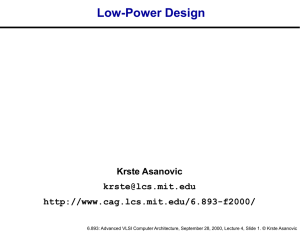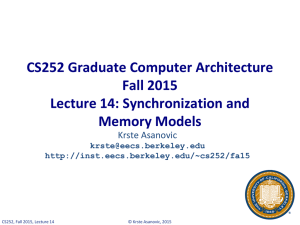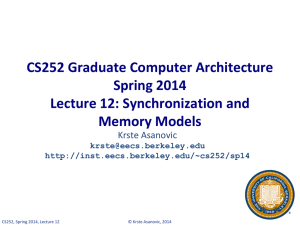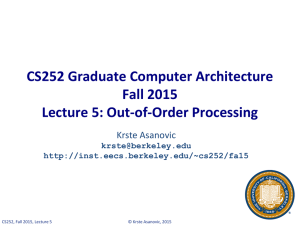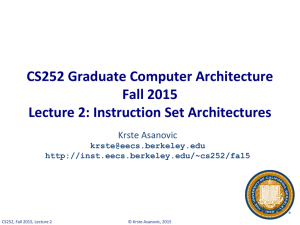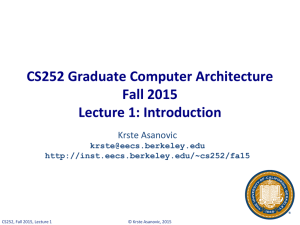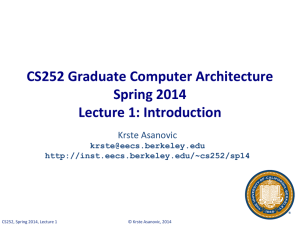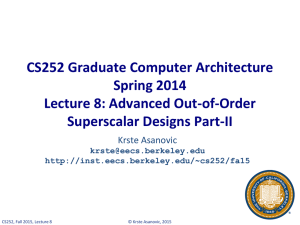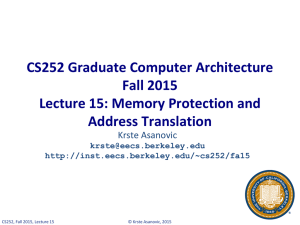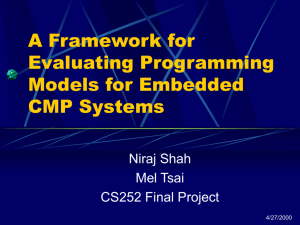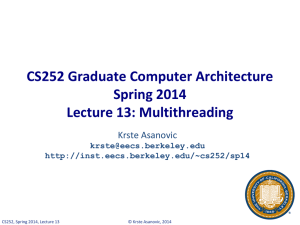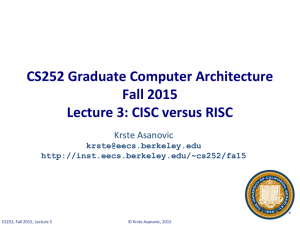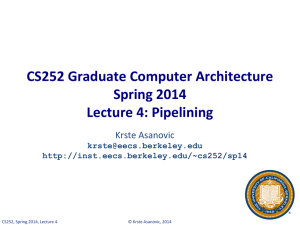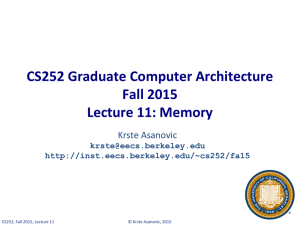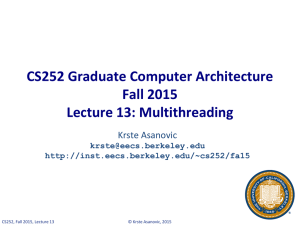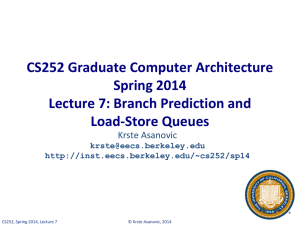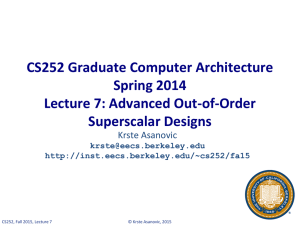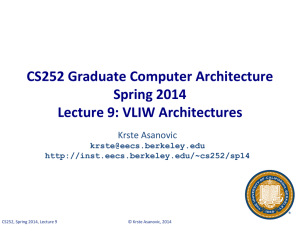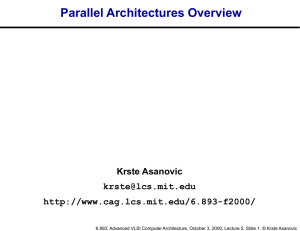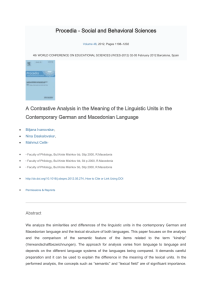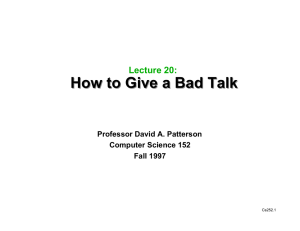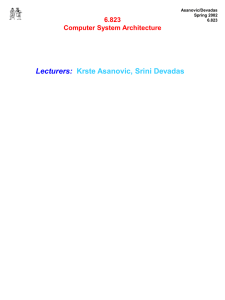CS252 Graduate Computer Architecture Spring 2014 Lecture 2: Instruction Set Architectures Krste Asanovic
advertisement
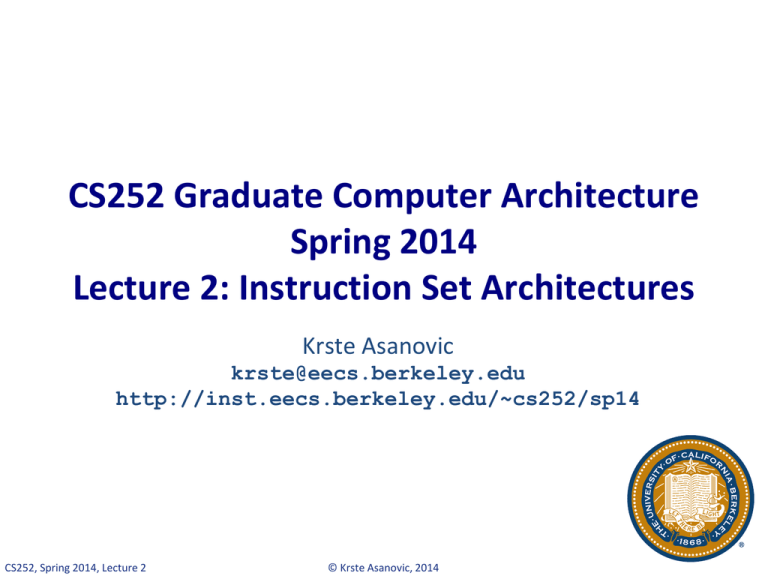
CS252 Graduate Computer Architecture Spring 2014 Lecture 2: Instruction Set Architectures Krste Asanovic krste@eecs.berkeley.edu http://inst.eecs.berkeley.edu/~cs252/sp14 CS252, Spring 2014, Lecture 2 © Krste Asanovic, 2014 Analog Computers Analog computer represents problem variables as some physical quantity (e.g., mechanical displacement, voltage on a capacitor) and uses scaled physical behavior to calculate results [BenFrantzDale, Creative Commons BY-SA 3.0] [Marsyas, Creative Commons BY-SA 3.0] Wingtip vortices off Cesna tail in wind tunnel Antikythera mechanism c.100BC CS252, Spring 2014, Lecture 2 © Krste Asanovic, 2014 Digital Computers Represent problem variables as numbers encoded using discrete steps - Discrete steps provide noise immunity Enables accurate and deterministic calculations - Same inputs give same outputs exactly Not constrained by physically realizable functions Programmable digital computers are CS252 focus CS252, Spring 2014, Lecture 2 © Krste Asanovic, 2014 3 Charles Babbage (1791-1871) Lucasian Professor of Mathematics, Cambridge University, 1828-1839 A true “polymath” with interests in many areas Frustrated by errors in printed tables, wanted to build machines to evaluate and print accurate tables Inspired by earlier work organizing human “computers” to methodically calculate tables by hand [Copyright expired and in public domain. Image obtained from Wikimedia Commons.] CS252, Spring 2014, Lecture 2 © Krste Asanovic, 2014 4 Difference Engine 1822 Continuous functions can be approximated by polynomials, which can be computed from difference tables: f(n) = n2 + n + 41 d1(n) = f(n) – f(n-1) = 2n d2(n) = d1(n) – d1(n-1) = 2 Can calculate using only a single adder: n 0 1 2 3 4 2 2 2 2 4 6 8 43 47 53 61 d2(n) d1(n) f(n) CS252, Spring 2014, Lecture 2 41 © Krste Asanovic, 2014 5 Realizing the Difference Engine Mechanical calculator, hand-cranked, using decimal digits Babbage did not complete the DE, moving on to the Analytical Engine (but used ideas from AE in improved DE 2 plan) Scheutz completed working version in 1855, sold copy to British Government Modern day recreation of DE2, including printer, showed entire design possible using original technology - first at British Science Museum - copy at Computer History Museum in San Jose [Geni, Creative Commons BY-SA 3.0 ] CS252, Spring 2014, Lecture 2 © Krste Asanovic, 2014 6 Analytical Engine 1837 Recognized as first general-purpose digital computer - Many iterations of the design (multiple Analytical Engines) Contains the major components of modern computers: - “Store”: Main memory where numbers and intermediate results were held (1,000 decimal words, 40-digits each) - “Mill”: Arithmetic unit where processing was performed including addition, multiplication, and division - Also supported conditional branching and looping, and exceptions on overflow (machine jams and bell rings) - Had a form of microcode (the “Barrel”) Program, input and output data on punched cards Instruction cards hold opcode and address of operands in store - 3-address format with two sources and one destination, all in store Branches implemented by mechanically changing order cards were inserted into machine Only small pieces were ever built CS252, Spring 2014, Lecture 2 © Krste Asanovic, 2014 7 Analytical Engine Design Choices Decimal, because storage on mechanical gears - Babbage considered binary and other bases, but no clear advantage over human-friendly decimal 40-digit precision (equivalent to >133 bits) - To reduce impact of scaling given lack of floating-point hardware Used “locking” or mechanical amplification to overcome noise in transferring mechanical motion around machine - Similar to non-linear gain in digital electronic circuits Had a fast “anticipating” carry - Mechanical version of pass-transistor carry propagate used in CMOS adders (and earlier in relay adders) CS252, Spring 2014, Lecture 2 © Krste Asanovic, 2014 8 Ada Lovelace (1815-1852) Translated lectures of Luigi Menabrea who published notes of Babbage’s lectures in Italy Lovelace considerably embellished notes and described Analytical Engine program to calculate Bernoulli numbers that would have worked if AE was built - The first program! Imagined many uses of computers beyond calculations of tables Was interested in modeling the brain [By Margaret Sarah Carpenter, Copyright expired and in public domain] CS252, Spring 2014, Lecture 2 © Krste Asanovic, 2014 9 Early Programmable Calculators Analog computing was popular in first half of 20th century as digital computing was too expensive But during late 30s and 40s, several programmable digital calculators were built (date when operational) - Atanasoff Linear Equation Solver (1939) Zuse Z3 (1941) Harvard Mark I (1944) ENIAC (1946) CS252, Spring 2014, Lecture 2 © Krste Asanovic, 2014 10 Atanasoff-Berry Linear Equation Solver (1939) Fixed-function calculator for solving up to 29 simultaneous linear equations Digital binary arithmetic (50-bit fixed-point words) Dynamic memory (rotating drum of capacitors) Vacuum tube logic for processing In 1973, Atanasoff was credited as inventor of “automatic electronic digital computer” after patent dispute with Eckert and Mauchly (ENIAC) [Manop, Creative Commons BY-SA 3.0 ] CS252, Spring 2014, Lecture 2 © Krste Asanovic, 2014 11 Zuse Z3 (1941) Built by Konrad Zuse in wartime Germany using 2000 relays Had normalized floating-point arithmetic with hardware handling of exceptional values (+/- infinity, undefined) - 1-bit sign, 7-bit exponent, 14-bit significand 64 words of memory Two-stage pipeline 1) fetch&execute 2) writeback No conditional branch Programmed via paper tape Replica of the Zuse Z3 in the Deutsches Museum, Munich CS252, Spring 2014, Lecture 2 © Krste Asanovic, 2014 [Venusianer, Creative Commons BY-SA 3.0 ] 12 Harvard Mark I (1944) Proposed by Howard Aiken at Harvard, and funded and built by IBM Mostly mechanical with some electrically controlled relays and gears Weighed 5 tons and had 750,000 components Stored 72 numbers each of 23 decimal digits Speed: adds 0.3s, multiplies 6s, divide 15s, trig >1 minute Instructions on paper tape (2-address format) Could run long programs automatically Loops by gluing paper tape into loops No conditional branch Although mentioned Babbage in proposal, was more limited than analytical engine [Waldir, Creative Commons BY-SA 3.0 ] CS252, Spring 2014, Lecture 2 © Krste Asanovic, 2014 13 ENIAC (1946) First electronic general-purpose computer Construction started in secret at UPenn Moore School of Electrical Engineering during WWII to calculate firing tables for US Army, designed by Eckert and Mauchly 17,468 vacuum tubes Weighed 30 tons, occupied 1800 sq ft, power 150kW Twelve 10-decimal-digit accumulators Had a conditional branch! Programmed by plugboard and switches, time consuming! Purely electronic instruction fetch and execution, so fast - 10-digit x 10-digit multiply in 2.8ms (2000x faster than Mark-1) As a result of speed, it was almost entirely I/O bound As a result of large number of tubes, it was often broken (5 days was longest time between failures) CS252, Spring 2014, Lecture 2 © Krste Asanovic, 2014 14 ENIAC Changing the program could take days! [Public Domain, US Army Photo] CS252, Spring 2014, Lecture 2 © Krste Asanovic, 2014 15 EDVAC ENIAC team started discussing stored-program concept to speed up programming and simplify machine design John von Nuemann was consulting at UPenn and typed up ideas in “First Draft of a report on EDVAC” Herman Goldstine circulated the draft June 1945 to many institutions, igniting interest in the stored-program idea - But also, ruined chances of patenting it - Report falsely gave sole credit to von Neumann for the ideas - Maurice Wilkes was excited by report and decided to come to US workshop on building computers Later, in 1948, modifications to ENIAC allowed it to run in stored-program mode, but 6x slower than hardwired - Due to I/O limitations, this speed drop was not practically significant and improvement in productivity made it worthwhile EDVAC eventually built and (mostly) working in 1951 - Delayed by patent disputes with university CS252, Spring 2014, Lecture 2 © Krste Asanovic, 2014 16 Manchester SSEM “Baby” (1948) Manchester University group build small-scale experimental machine to demonstrate idea of using cathode-ray tubes (CRTs) for computer memory instead of mercury delay lines Williams-Kilburn Tubes were first random access electronic storage devices 32 words of 32-bits, accumulator, and program counter Machine ran world’s first stored-program in June 1948 Led to later Manchester Mark-1 full-scale machine - Mark-1 introduced index registers - Mark-1 commercialized by Ferranti [Piero71, Creative Commons BY-SA 3.0 ] Williams-Kilburn Tube Store CS252, Spring 2014, Lecture 2 © Krste Asanovic, 2014 17 Cambridge EDSAC (1949) Maurice Wilkes came back from workshop in US and set about building a stored-program computer in Cambridge EDSAC used mercury-delay line storage to hold up to 1024 words (512 initially) of 17 bits (+1 bit of padding in delay line) Two’s-complement binary arithmetic Accumulator ISA with self-modifying code for indexing David Wheeler, who earned the world’s first computer science PhD, invented the subroutine (“Wheeler jump”) for this machine - Users built a large library of useful subroutines UK’s first commercial computer, LEO-I (Lyons Electronic Office), was based on EDSAC, ran business software in 1951 - Software for LEO was still running in the 1980s in emulation on ICL mainframes! EDSAC-II (1958) was first machine with microprogrammed control unit CS252, Spring 2014, Lecture 2 © Krste Asanovic, 2014 18 Commercial computers: BINAC (1949) and UNIVAC (1951) Eckert and Mauchly left U.Penn after patent rights disputes and formed the Eckert-Mauchly Computer Corporation World’s first commercial computer was BINAC with two CPUs that checked each other - BINAC apparently never worked after shipment to first (only) customer Second commercial computer was UNIVAC - Used mercury delay-line memory, 1000 words of 12 alpha characters - Famously used to predict presidential election in 1952 - Eventually 46 units sold at >$1M each - Often, mistakingly called the IBM UNIVAC CS252, Spring 2014, Lecture 2 © Krste Asanovic, 2014 19 Administrivia Piazza for discussions – please sign up! Who’s not enrolled in class yet? CS252, Spring 2014, Lecture 2 © Krste Asanovic, 2014 20 Required Textbook For class, we’ll be using 5th edition of Hennessy and Patterson, “Computer Architecture: A Quantitative Approach” Background reading will be listed on website for each class. Assumption is that this is read before class. No reviews required. CS252, Spring 2014, Lecture 2 © Krste Asanovic, 2014 21 Reading Discussion CS252, Spring 2014, Lecture 2 © Krste Asanovic, 2014 22 IBM 701 (1952) IBM’s first commercial scientific computer Main memory was 72 William’s Tubes, each 1Kib, for total of 2048 words of 36 bits each - Memory cycle time of 12µs Accumulator ISA with multipler/quotient register 18-bit/36-bit numbers in sign-magnitude fixed-point Misquote from Thomas Watson Sr/Jr: “I think there is a world market for maybe five computers” Actually TWJr said at shareholder meeting: “as a result of our trip [selling the 701], on which we expected to get orders for five machines, we came home with orders for 18.” CS252, Spring 2014, Lecture 2 © Krste Asanovic, 2014 23 IBM 650 (1953) The first mass-produced computer Low-end system with drum-based storage and digit serial ALU Almost 2,000 produced [Cushing Memorial Library and Archives, Texas A&M, Creative Commons Attribution 2.0 Generic ] CS252, Spring 2014, Lecture 2 © Krste Asanovic, 2014 24 IBM 650 Architecture Magnetic Drum (1,000 or 2,000 10-digit decimal words) Active instruction (including next program counter) Digit-serial ALU 20-digit accumulator CS252, Spring 2014, Lecture 2 [From 650 Manual, © IBM] © Krste Asanovic, 2014 25 IBM 650 Instruction Set Address and data in 10-digit decimal words Instructions encode: - Two-digit opcode encoded 44 instructions in base instruction set, expandable to 97 instructions with options - Four-digit data address - Four-digit next instruction address - Programmer’s arrange code to minimize drum latency! Special instructions added to compare value to all words on track CS252, Spring 2014, Lecture 2 © Krste Asanovic, 2014 26 Early Instruction Sets Very simple ISAs, mostly single-address accumulator- style machines, as high-speed circuitry was expensive - Based on earlier “calculator” model Over time, appreciation of software needs shaped ISA Index registers (Kilburn, Mark-1) added to avoid need for self-modifying code to step through array Over time, more index registers were added And more operations on the index registers Eventually, just provide general-purpose registers (GPRs) and orthogonal instruction sets But some other options explored… CS252, Spring 2014, Lecture 2 © Krste Asanovic, 2014 27 Burrough’s B5000 Stack Architecture: Robert Barton, 1960 Hide instruction set completely from programmer using high-level language (ALGOL) Use stack architecture to simplify compilation, expression evaluation, recursive subroutine calls, interrupt handling,… CS252, Spring 2014, Lecture 2 © Krste Asanovic, 2014 28 Evaluation of Expressions (a + b * c) / (a + d * c - e) / + a - b e + * c a * d c * Reverse Polish abc*+adc*+e-/ push abc push push multiply CS252, Spring 2014, Lecture 2 © Krste Asanovic, 2014 c b b* c a Evaluation Stack 29 Evaluation of Expressions (a + b * c) / (a + d * c - e) / + a - b e + * c a * d c Reverse Polish abc*+adc*+e-/ add CS252, Spring 2014, Lecture 2 © Krste Asanovic, 2014 + b*c a + ba * c Evaluation Stack 30 Stacks post-1980 Inmos Transputers (1985-2000) - Designed to support many parallel processes in Occam language Fixed-height stack design simplified implementation Stack trashed on context swap (fast context switches) Inmos T800 was world’s fastest microprocessor in late 80’s Forth machines - Direct support for Forth execution in small embedded real-time environments - Several manufacturers (Rockwell, Patriot Scientific) Java Virtual Machine - Designed for software emulation, not direct hardware execution - Sun PicoJava implementation + others Intel x87 floating-point unit - Severely broken stack model for FP arithmetic - Deprecated in Pentium-4, replaced with SSE2 FP registers CS252, Spring 2014, Lecture 2 © Krste Asanovic, 2014 31 Acknowledgements This course is partly inspired by previous MIT 6.823 and Berkeley CS252 computer architecture courses created by my collaborators and colleagues: - Arvind (MIT) Joel Emer (Intel/MIT) James Hoe (CMU) John Kubiatowicz (UCB) David Patterson (UCB) CS252, Spring 2014, Lecture 2 © Krste Asanovic, 2014 32
